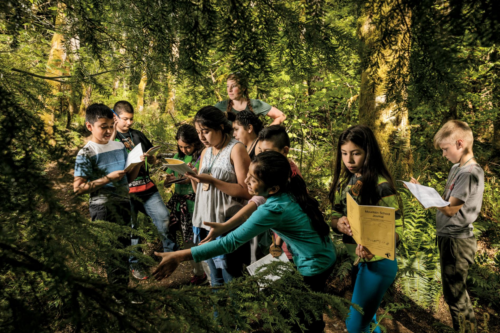Mountain School in National Geographic magazine

We are thrilled to have been included in Tim Egan’s cover story for the October 2016 issue of National Geographic!
“In early fall I went to North Cascades National Park — the American Alps, chock-full of glaciers containing the frozen memories of wet winters past. A bundle of high peaks in Washington State, the park is one of the most remote places in the contiguous 48 states and also one of the least visited parks. But here, deep in the forested embrace of the upper Skagit River Valley, you can find the next two generations of Americans getting to know a national park. I heard hooting like owls and howling like wolves, coming from a circle of fifth graders and their wilderness instructors. The kids were from Birchwood Elementary in Bellingham, Washington, a school where almost half the students are nonwhite and most had never been in a national park. They were there for Mountain School, three days in outdoor immersion run by the North Cascades Institute. Their guides—staff naturalists, park rangers, graduate students—were all millennials. Without exception, the instructors thought the concern about their generation’s attachment to the land was valid, but overstated.
“It’s not like all of a sudden people are going to stop loving nature,” said Emma Ewert, who had gone to Mountain School and returned as an instructor. “But you do need the exposure, the fun of playing in the woods.” For that, perhaps, we should look to today’s parents, those afraid to let their children wander a little bit on their own.
The institute’s co-founder and executive director, Saul Weisberg, is a self-described Jewish kid from New York by way of Cleveland. He’s 62 now, wiry, with a bounce to his step. He learned to love the parks from his family, camping in a tent not unlike the one my folks used. He became a seasonal ranger at North Cascades and noticed a troubling pattern among visitors. “I don’t think I ever saw a person of color in the backcountry,” he said. He started Mountain School in 1990, partnering with the Park Service. About 3,000 students a year go through the program.
Though these kids lived only two hours or so away, this park was a strange new world for them. Many said it was the first time they’d been off the electronic leash of a family smartphone. “They have a very short attention span,” Ewert said.
At Mountain School, the instructors note changes in behavior over the few days the kids spend in the forest. They start to identify types of trees and small animals, and notice distinctions in sounds and smells. “Parents say, ‘What did you do to my child?’ ” said Carolyn Hinshaw, a teacher at Birchwood.
The parks director, Jarvis, is a big fan of Mountain School and similar programs, like Nature Bridge, which brings 30,000 students every year to a half dozen national parks. But he cautions that one visit does not a park lover make. “Something clicks, a light goes on, just by having some exposure,” he said. “I think it takes three touches for someone to change. A great first impression, but no follow-through, is not enough.” What’s needed, he said, is a broad cultural shift—a return, of sorts, to a time when outdoor exposure was a basic nutrient of American life.”
Read the rest of “Can the Selfie Generation Unplug and Get Into Parks?” at www.nationalgeographic.com/magazine/2016/10/unplugging-the-selfie-generation-national-parks.

